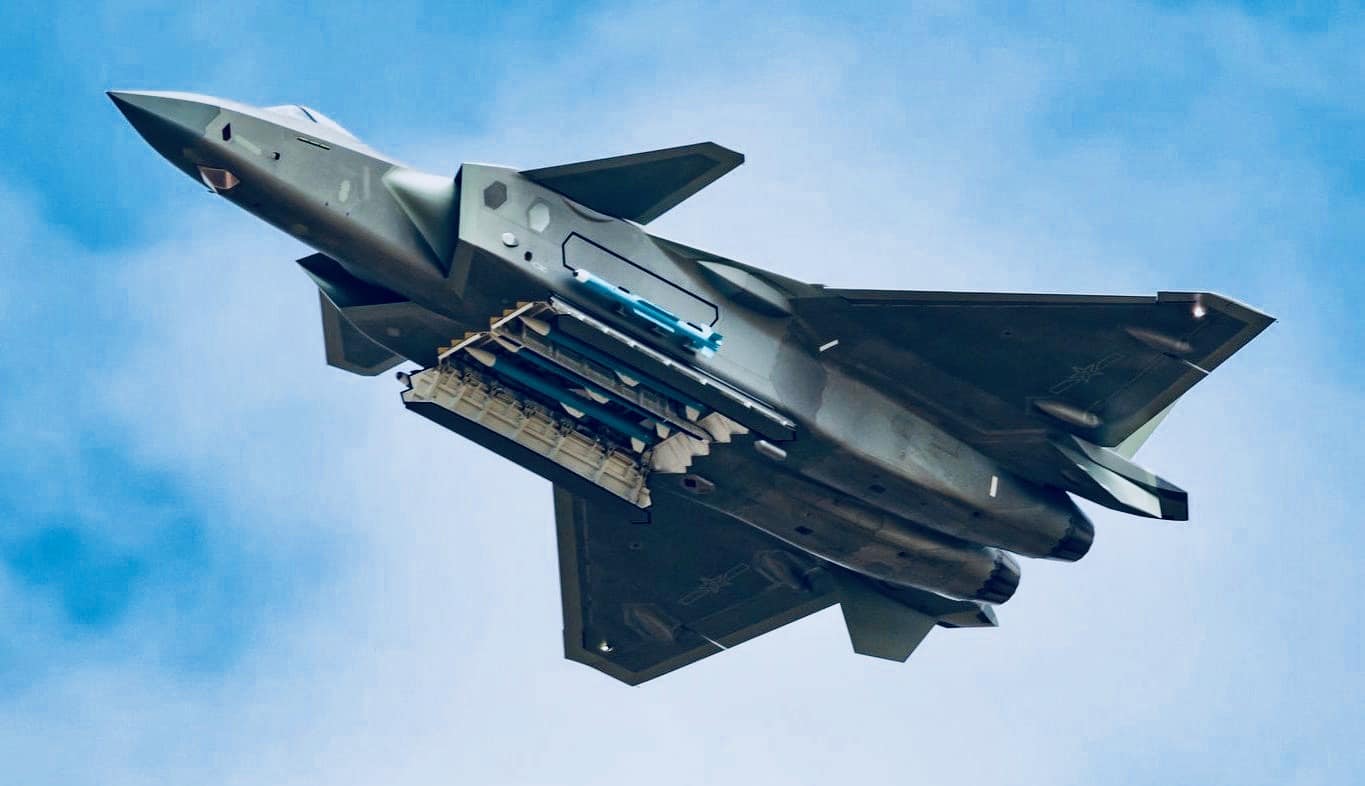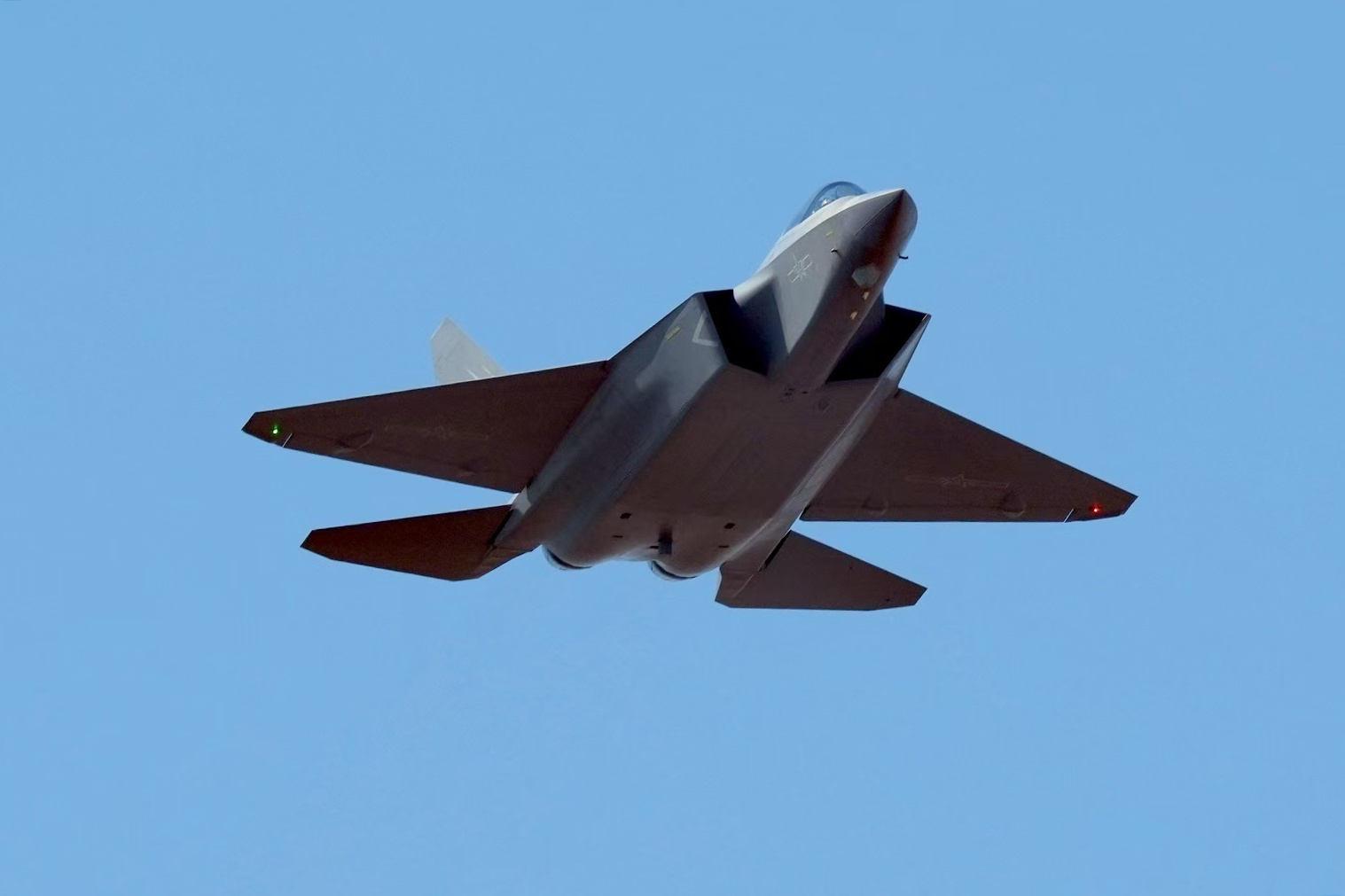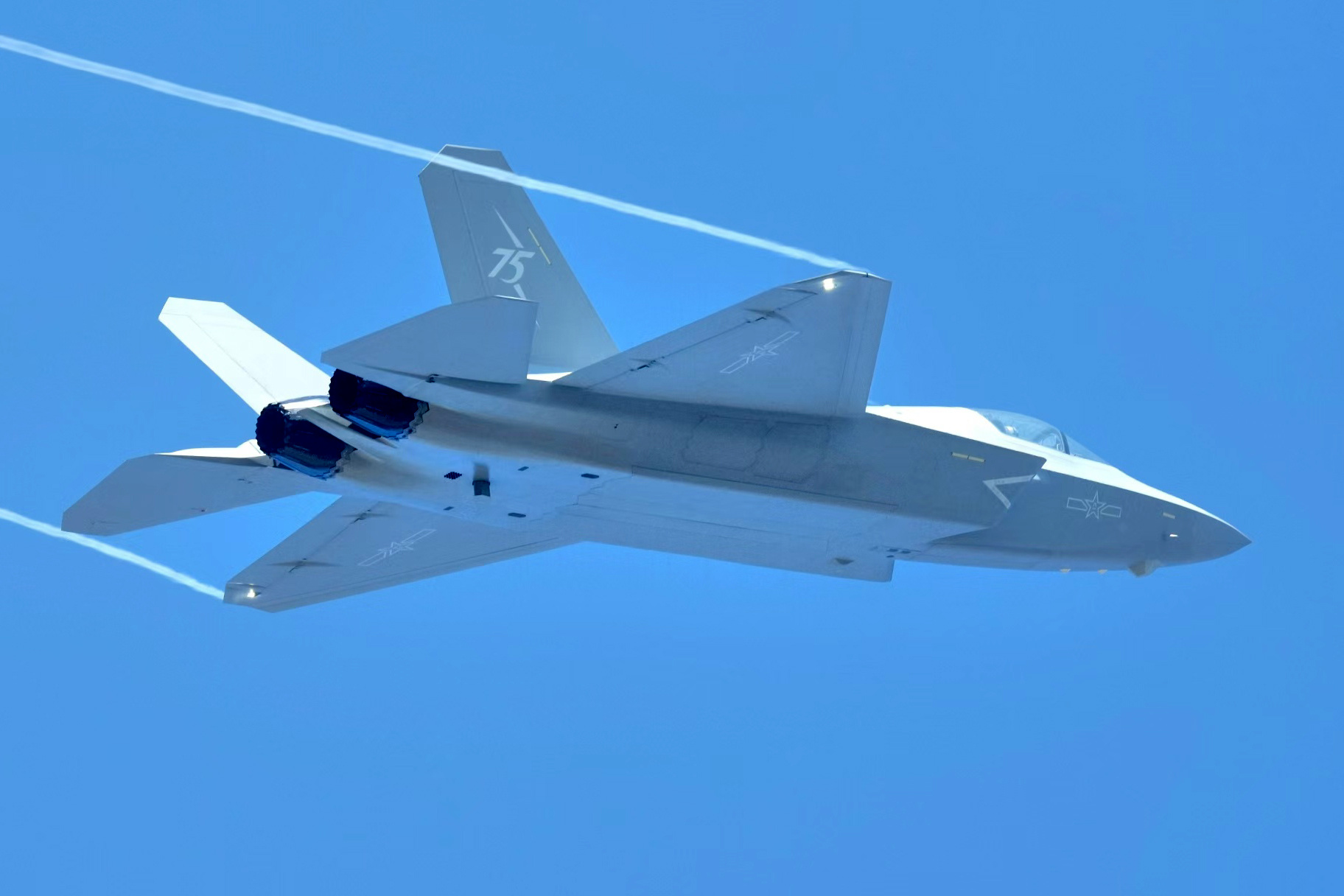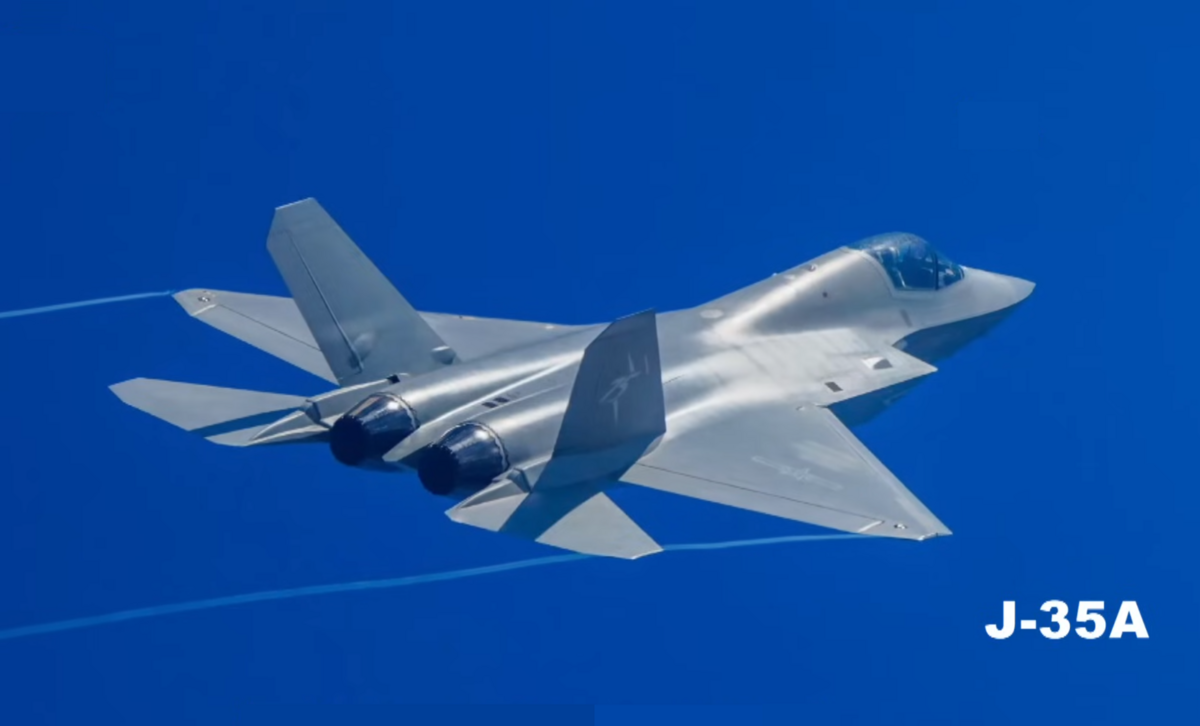PL-21 Emerges: China’s Deadliest Air-to-Air Missile May Soon Arm Pakistan’s Stealth J-35A
The appearance of the PL-21 on China’s most advanced air superiority fighter has reignited interest among Pakistani defence analysts, especially considering the Pakistan Air Force’s (PAF) plans to induct the stealth J-35A in the near future.
(DEFENCE SECURITY ASIA) – A recently surfaced image has triggered intense scrutiny among global defence analysts after it allegedly showed China’s fifth-generation stealth fighter, the Chengdu J-20, armed with what appears to be two PL-21 ultra-long-range air-to-air missiles.
Although the image lacks official authentication and remains blurred, experts believe it provides one of the clearest visual indicators yet that the People’s Liberation Army Air Force (PLAAF) is progressing with advanced trials of the highly secretive missile.
Detailed assessments suggest that the aircraft in question is indeed a J-20, and the missiles mounted beneath its wings strongly resemble the profile and configuration associated with the PL-21, a weapon system designed to strike high-value airborne targets at strategic distances.
The appearance of the PL-21 on China’s most advanced air superiority fighter has reignited interest among Pakistani defence analysts, especially considering the Pakistan Air Force’s (PAF) plans to induct the stealth J-35A in the near future.
According to local media reports, PAF is expected to receive its first batch of J-35A fifth-generation multirole fighters as early as next year, making the possibility of PL-21 integration a subject of growing excitement in Islamabad.
Pakistani observers hope to mirror the precedent set by China’s transfer of the PL-15 missile to the PAF for its J-10C fleet, which is believed to have delivered strategic success during recent aerial engagements with India.
“Excited by the performance of Pakistan’s J-10C fighters equipped with PL-15 air-to-air missiles—believed to have successfully shot down several Indian Air Force jets—Pakistani defence observers are now eager to see their upcoming J-35A or J-10C similarly armed with the PL-21.”

Under the initial agreement, Pakistan was scheduled to begin receiving the first of 40 J-35A aircraft towards the end of 2026, but the revised timeline underscores the urgency driving bilateral defence collaboration.
While these developments have yet to be officially acknowledged by Islamabad, the PAF, or SAC, the weight of the reports adds to mounting expectations that Pakistan’s future air combat capability is on the cusp of a generational leap.
Reports from late 2024 first revealed Pakistan’s plans to procure 40 J-35A stealth fighters—marking the first known export of a fifth-generation fighter aircraft by China, a milestone Beijing is eager to showcase in its rise as a global defence exporter.
During the most recent India-Pakistan conflict, Islamabad claimed to have downed six Indian fighters using PL-15-equipped J-10Cs, including three Rafales, one Su-30MKI, one MiG-29, and one Mirage 2000, though India has publicly denied suffering any such losses.
The PL-21, which remains under active development by Chinese defence firms, is envisioned as a next-generation missile capable of targeting AWACS, refuelling tankers, and electronic warfare aircraft from ranges exceeding 400 kilometers.
Its purpose-built design makes it a strategic “AWACS killer,” crafted not to engage enemy fighters, but to dismantle an adversary’s air combat network from standoff distances, long before the platform is aware of the threat.

Recent sightings on Chinese social media indicate that the PL-21 possesses a larger and longer body, most likely incorporating ramjet or scramjet propulsion, enabling high-speed, sustained thrust over extended flight profiles.
The missile is expected to carry an AESA radar seeker, advanced electronic counter-countermeasures (ECCM), and high survivability against jamming and spoofing in complex electronic warfare environments.
According to some sources, the PL-21 may also integrate two-way encrypted datalinks, allowing real-time targeting updates from launch platforms or AEW&C aircraft such as the KJ-500, even during the missile’s mid-course flight phase.
Strategically, PL-21 represents a leap in China’s “airborne area-denial” doctrine, giving it the capability to force enemy high-value assets to operate far from contested zones or risk being neutralized before delivering combat support.
Western airborne command and support aircraft such as the E-3 Sentry, KC-135 Stratotanker, and RC-135 Rivet Joint would no longer enjoy immunity at the rear, which directly impacts operations involving the F-22, F-35, and allied stealth assets.
Designed to be deployed from long-range interceptors like the J-16, J-20, and the forthcoming J-20B, the PL-21 enables strike operations against airborne enablers without compromising the safety of the launch platform.
Many analysts view the PL-21 as China’s direct response to the AIM-260 JATM (Joint Advanced Tactical Missile) program under development in the United States to replace the AIM-120D AMRAAM.

In future high-intensity conflicts across the Indo-Pacific, where air engagements may occur beyond 300 kilometers and rely heavily on AEW&C and satellite-fed ISR, the PL-21 could define which side controls the sky before the first fighter closes within visual range.
Its potential deployment in regions like the South China Sea, East China Sea, or Taiwan Strait would significantly impact strategic calculations of U.S. allies including Japan, South Korea, and Australia.
Despite no official confirmation from Chinese authorities, multiple sightings and probable test launches suggest the PL-21 has entered advanced development and may soon be inducted into frontline PLAAF units.
If the PL-15 transformed conventional BVR air combat, the PL-21 could revolutionize strategic aerial warfare, prioritizing support-kill strategies over dogfighting or maneuver dominance.
Should the missile be exported to Pakistan, PAF’s future J-35A fleet could deliver long-range strikes against Indian Netra AEW&C, Phalcon AWACS, and Il-78 tankers from standoff ranges, neutralizing India’s aerial C4ISR backbone before traditional combat begins.
Such a capability would allow the PAF to exploit the full spectrum of the “first look, first shoot, first kill” doctrine, reducing the need to penetrate Indian airspace while striking critical airborne enablers.
With advanced ECCM and high-fidelity datalinks, the PL-21 would also significantly upgrade Pakistan’s electronic warfare posture, making J-35A + PL-21 a high-survivability pairing in next-generation conflict zones.

India, in response, would likely accelerate its own long-range missile programs, including the AIM-260 JATM via U.S. partnership or expand its Meteor missile inventory for its Rafale squadrons.
Simultaneously, India would be compelled to enhance its layered air defence networks, integrating systems like the S-400 Triumf, Akash-NG, and LR-SAM to shield its airborne C4I assets.
Should Pakistan become the first foreign operator of the PL-21, it would once again serve as China’s live demonstration partner, as seen with the PL-15E, validating system effectiveness and expanding China’s defence export market.
Countries such as Iran, Egypt, and select Gulf states could become future buyers, attracted by the PL-21’s potential to counter superior Western air assets without matching them platform-for-platform.
With J-35A and PL-21 in its arsenal, Pakistan would join a small group of air forces capable of ultra-long-range strategic air-to-air strikes, aligning it with China, the United States, and potentially Russia.

This development would compel India to conduct a comprehensive overhaul of its air warfare doctrine, shifting from legacy dogfighting concepts to standoff, electronically contested combat where superiority is defined by reach and disruption.
As regional tensions mount and the Indo-Pacific arms race accelerates, the PL-21’s emergence may mark the tipping point in a new era of air dominance—one where victory is dictated not by who flies faster, but by who shoots first from furthest and blinds the enemy before the battle begins.
— DEFENCE SECURITY ASIA


